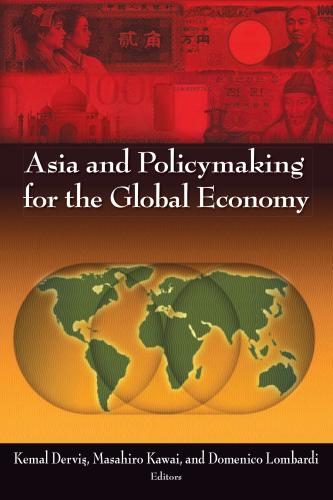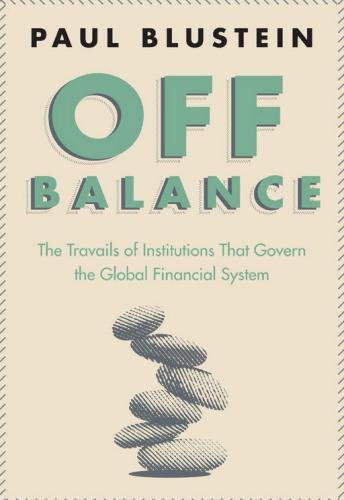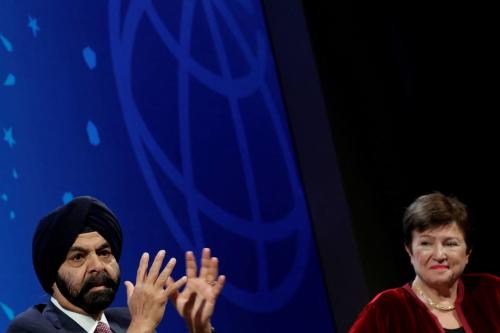Editor’s Note: The International Monetary Fund (IMF) conducts regular surveillance with members on economic policies. In a speech to the IMF’s Executive Board, Domenico Lombardi and Ngaire Woods discuss the effectiveness of the Fund’s surveillance efforts and offers recommendations for potential improvement that would aid internationally monetary cooperation.
View the power point presentation »
It is truly a privilege for us to be meeting with IMF Board members today and we are grateful to Mr. Shaalan, Dean of the Executive Board and Executive Director for the Constituency of Egypt, and to Mr. Fried, Executive Director for the Constituency of Canada, for their very kind invitation. And not only because one of us spent here some of the most rewarding time of his earlier career but, most importantly, because we see our being here today as testimony to the increasing openness of this distinguished forum to more dialogue and exchange—a key feature to which we shall return in the course of this meeting.
Introduction
Under the Bretton Woods regime, the IMF’s role as overseer of the system of fixed exchange rates was central to the international monetary system overall. For as long as this arrangement lasted, the Fund conducted a form of surveillance that was both bilateral and multilateral by monitoring the sustainability of exchange rates and their consistency vis-à-vis the broader par value system.
When Bretton Woods collapsed, IMF surveillance changed. The new surveillance framework, which was part of the Second Amendment of 1978, laid the ground for Fund surveillance as we know it today. The new system put greater weight on consultations and national-level responsibility in the absence of international rules. At the heart of the revised Art. IV was a shift in authority back to member countries and away from the IMF. The IMF still bore the task of helping its members to avoid the unilateral setting of exchange rate policy by individual nations, but members had taken sovereignty over their economic policies back in hand, leaving the IMF with few, if any, instruments with which to fulfill its task. This contradictory feature of the Fund’s mandate on surveillance has yet to be resolved by the IMF membership, as the limited IMF role in the current financial turmoil confirms.
Structure of presentation
We will examine the effectiveness of IMF surveillance by identifying three means of policy diffusion, drawing on theories of international relations: provision of information, peer review and, finally, the leveraging of power relations to amplify conditionality.
For each of the three ways in which IMF surveillance can affect policies in member countries, we have gathered available evidence from internal (public) IMF reviews as well as from scholarly research; we have documented the effectiveness of surveillance in relation to each of those channels and then elaborated on the implications for the future of IMF surveillance and, in particular, the role of the Board.
IMF Surveillance as Provider of Information
The effect of the information pooled, analyzed, and disseminated by the IMF can be looked at in one of two ways. One could argue that information provided by the IMF enables countries and their policymakers to update their thinking so as to permit new forms of competition and cooperation, by reducing countries’ uncertainty about the behavior of other countries, including their acceptance of mutually-agreed rules. IMF surveillance also provides information to markets, which in turn influence policymakers in the adoption of measures that the former consider attractive—such as policies aimed at increasing the efficiency of financial markets or at attracting more foreign investment.
Alternatively, one might ask how new information can induce policy change, that is, how the IMF frames and delivers information to guarantee its reception—learning is not a passive activity whereby technical information is simply passed on and automatically or necessarily absorbed by others.
IMF Surveillance as Peer Review
Peer review depicts surveillance as a machinery of collaboration in which peers, that is, governments, learn from each other. To this end, the IMF was created as “machinery”—to quote the Articles of Agreement—to make international cooperation a framework within which countries can forge common goals and the means to achieve such goals. In the context of this mechanism, “cooperation” is a process that might produce social pressures, which might in turn shape governments’ judgments on what they should and should not do. Peer pressure such as this might influence a government to adopt certain policy standards in order to avoid the stigma that its peers would place on it for deviating from socially- or internationally-accepted norms. A key factor in this process is that any peer review should be a two-way exercise, aimed to create shared knowledge that then becomes available to the entire group through the benchmarking of best practices and policies.
IMF Surveillance as an Amplifier of Conditionality
The last channel of influence, power relations, recognizes the power asymmetries among members of the IMF and between the institution and its (potential) borrowing members. Here, effective surveillance is seen as dependent upon the asymmetric and hierarchical power relationship between the IMF and those member countries likely to be structurally or situationally reliant on it.
This was not part of the original conception of the monitoring and consultation role of the IMF, which had a credit-union character whereby all members were deemed to be equally likely to apply for temporary Balance of Payment support to uphold the fixed exchange rate system. Over time, however, IMF members have become divided into creditors and potential borrowers, creating a source of leverage by the former over the latter.
Provider of Information—Evidence
Current practices highlight the limited involvement of the Executive Board in multilateral surveillance, where the WEO is the outcome of a highly structured process almost entirely staff-driven. Eventually, the WEO gets to the Board for discussion, but many of the interventions at that point concern factual clarifications and drafting suggestions. Finally, the WEO is published with a disclaimer that the views expressed are those of the staff and should not be attributed to the Board, whose appraisal is contained in a summing up enclosed with the publication. Accordingly, the WEO is presented as a staff document in the press conference that precedes its publication.
In terms of content, the IMF’s own Internal Evaluation Office has documented the uneven and untimely coverage in the WEO of critical concerns like exchange rate issues and global imbalances, which were covered only after they had become topical.
All in all, available evidence suggests that the multilateral surveillance of the IMF is not focused on generating debate about urgent problems and possible cooperative solutions. The WEO report, due to the process that produces it, is almost guaranteed to eliminate the possibility of disagreement or debate. The limited involvement of the Executive Board, in turn, implies that the exercise has become focused on the production of the report itself, rather than on the process of coordinating national member states’ policies.
A different account of surveillance holds that the provision of information by the IMF affects policy by catalyzing market pressures. This logic inspired the international standards initiative, which was explicitly aimed at market participants. Here, internal and external evidence consistently point to a lack of familiarity and of use of ROSCs by market participants, although they seem to make greater use of Art. IV reports, not primarily designed to deliver information to market participants. Market participants also make little use of the IMF’s multilateral surveillance reports, including the Global Financial Stability Report (GFSR).
Peer Review—Evidence
Evidence also points to the limited role of the Executive Board in considering or commenting on the design of forthcoming surveillance missions, as this whole process, too, is staff-driven. The Board does, however, devote some 130 discussions each year to appraising members’ economic policies, though these meetings evidently have little effect on the ultimate appraisals made by staff. The only influence the Board has over bilateral surveillance really is to place different degrees of emphasis on the various issues raised in the staff appraisal and to voice such emphasis in a summing up, an initial draft of which is prepared by staff prior to the Board discussion.
There is another way surveillance might affect members, that is, not through its formal ability to enforce agreed-upon rules but rather by the informed competition it creates among member states. This is most evident with regard to compliance with Art. VIII. Beth Simmons of Harvard finds that member countries have not rushed to “subscribe” to Art. VIII, which has only a 50 percent probability of adherence within 31 years, increasing to 75 percent after 40 years. Simmons finds relatively stronger evidence, however, of peer competition with respect to variables proxying for economic conditions and market pressures, which exert only a second-order effect. She concludes that “the behavior of other countries, especially in one’s own region, has far more influence on commitment and compliance that has generally been recognized.”
Do ROSCs provide information that alters competition among governments or market pressures? Walters of the LSE argues that peer pressure on countries only exists as far as the signing up and implementation of standards goes. He finds much less evidence of peer pressure to actually comply with those implemented standards.
The IMF’s internal reviews admit that “hard evidence on the impact of the initiative on countries’ adherence to the standards is not available” and that “there is neither a mechanism to track systematically members’ implementation of ROSC recommendations nor the extent and degree of their observance of the standard in all ROSCs.”
From the gap between subscription to compliance, we can infer one of two things. If we believe that the subscription to, for instance, the data dissemination standard (SDDS) sends a positive signal to capital markets, then perhaps subscription alone meets the objective of the subscribing country, which garners no additional benefit in complying with the standard. Alternatively, countries might sign up for the SDDS more as a show of cooperation with the IMF than as a signal to markets. In other words, they sign up to send a political message to markets that they indeed have IMF support. Thus financial markets, aware that market participants may be more interested in the signal of subscription rather than the actual standard itself, may be somewhat indifferent to the SDDS, other standards, or the associated reports.
So the question then becomes, why do countries request a ROSC? To start, a country that regularly undergoes ROSCs is perceived by the IMF as more cooperative with the institution that those countries that do not participate. The Fund’s Board sees ROSCs as an important way to ensure that member countries engage with the institution. Since the inception of the international standards initiative, the Board has reviewed the latter—how many countries have subscribed to it? how many more could?—at regular intervals of about two years, while the staff has compiled and circulated to the Board a quarterly update on the subscribers. International standards of course also constitute part of the policy dialogue with the authorities in the context of Art. IV statutory missions.
Amplifier of Conditionality—Evidence
Today, surveillance as an amplifier of conditionality is most readily observed in the IMF’s relationships with aid-dependent countries. The IMF acts as a “gatekeeper” for most official flows. For instance, official debt restructuring is negotiated through the Paris Club, which has traditionally required participation in an IMF-supported program as a pre-requisite to debt restructuring or cancellation. A recent IMF survey reports that 97 percent of donor members use IMF assessments to inform their decisions about assistance to low-income countries. Most recently, the IMF set up the Policy Support Instrument for countries that do not want (or need) to enter into a financial arrangement with the IMF. Nigeria, the first country to apply for the PSI, obtained debt restructuring from the Paris Club upon satisfactory PSI performance.
When the IMF conducts surveillance, its findings affect low-income countries most of all—partly because borrowing governments take more notice of it, partly because there is no competing source of information, and partly because donors consider it an authoritative assessment.
Conclusions
Surveillance is effective in those countries that cannot afford to be noncompliant with the IMF, where noncompliance would affect their other sources of multilateral and bilateral aid.
In countries where the Fund has no leverage, surveillance still appears to have some traction, albeit limited. IMF surveillance provides information that does seem to influence countries by affecting competition among peers—as seen by the growing rate of adoption of IMF standards. However, this does not mean that surveillance influences countries’ substantive policies.
As for market pressures, markets could be reacting more to members’ political signals of their willingness to cooperate with the Fund than to these members’ actual compliance with the standards. This is consistent with the view that surveillance is effective not as a provider of information to markets per se, but as a signal to markets about the relative standing of a country within the IMF.
The way it is structured, IMF surveillance offers little peer-to-peer exchange and, all in all, there is little evidence that both bilateral and multilateral surveillance leads to learning and socialization, as the Board and the membership at large exhibit little ownership of the results.
This reflects not only the way the IMF engages with countries but also the limited degree to which members themselves have delegated authority to the institution. Members have in fact provided neither adequate authority nor any effective instrument of enforcement. They have pulled back from endowing the IMF with political capital, making it ineffective as a forum for multilateral solution-finding.
For the IMF to undertake more effective surveillance, a reinvigoration of the collaborative machinery of the organization is required. The IMF Board would need to reclaim greater control over the strategic direction of the institution and replace bureaucratic procedures with more open and informal dialogue.
Likewise, the Fund’s bilateral surveillance activities would need to be more member-driven, less prescriptive, and more open to peer participation if they are to invite learning and cooperation. The EU and OECD models of peer surveillance are instructive. By adopting processes that foster greater engagement among member countries, the IMF would be able to generate more engagement of senior officials and reinvigorate its “machinery” function for international monetary cooperation.







Commentary
Should the International Monetary Fund Do Surveillance?
July 16, 2008